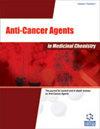Thiosemicarbazone-benzene Sulfonamide Derivatives as Human Carbonic Anhydrases Inhibitors: Synthesis, Characterization, and In silico Studies
IF 2.6
4区 医学
Q3 CHEMISTRY, MEDICINAL
Anti-cancer agents in medicinal chemistry
Pub Date : 2024-02-16
DOI:10.2174/0118715206290722240125112447
引用次数: 0
Abstract
Introduction: Carbonic anhydrases (CAs) are widespread metalloenzymes with the core function of catalyzing the interconversion of CO2 and HCO3-. Targeting these enzymes using selective inhibitors has emerged as a promising approach for the development of novel therapeutic agents against multiple diseases. Method: A series of novel thiosemicarbazones-containing derivatives were synthesized, characterized, and tested for their inhibitory activity against pharmaceutically important human CA I (hCA I), II (hCA II), IX (hCA IX), and XII (hCA XII) using the single tail approach. Result: The compounds generally inhibited the isoenzymes at low nanomolar concentrations, with compound 6b having Ki values of 7.16, 0.31, 92.5, and 375 nM against hCA I, II, IX and XII, respectively. Compound 6e exhibited Ki values of 27.6, 0.34, 872, and 94.5 nM against hCA I, II, IX and XII, respectively. Conclusion: To rationalize the inhibition data, molecular docking studies were conducted, providing insight into the binding mechanisms, molecular interactions, and selectivity of the compounds towards the isoenzymes.作为人类碳酸酐酶抑制剂的硫代氨基脲-苯磺酰胺衍生物:合成、表征和硅学研究
简介:碳酸酐酶(CAs)是一种广泛存在的金属酶,其核心功能是催化 CO2 和 HCO3- 的相互转化。利用选择性抑制剂靶向这些酶,已成为开发治疗多种疾病的新型药物的一种很有前景的方法。方法:采用单尾法合成、表征和测试了一系列新型含硫代氨基甲酸脲衍生物,这些衍生物对药学上重要的人类 CA I(hCA I)、II(hCA II)、IX(hCA IX)和 XII(hCA XII)具有抑制活性。结果:化合物 6b 对 hCA I、II、IX 和 XII 的 Ki 值分别为 7.16、0.31、92.5 和 375 nM。化合物 6e 对 hCA I、II、IX 和 XII 的 Ki 值分别为 27.6、0.34、872 和 94.5 nM。结论为了使抑制数据合理化,我们进行了分子对接研究,以深入了解化合物的结合机制、分子相互作用以及对同工酶的选择性。
本文章由计算机程序翻译,如有差异,请以英文原文为准。
求助全文
约1分钟内获得全文
求助全文
来源期刊

Anti-cancer agents in medicinal chemistry
ONCOLOGY-CHEMISTRY, MEDICINAL
CiteScore
5.10
自引率
3.60%
发文量
323
审稿时长
4-8 weeks
期刊介绍:
Formerly: Current Medicinal Chemistry - Anti-Cancer Agents.
Anti-Cancer Agents in Medicinal Chemistry aims to cover all the latest and outstanding developments in medicinal chemistry and rational drug design for the discovery of anti-cancer agents.
Each issue contains a series of timely in-depth reviews and guest edited issues written by leaders in the field covering a range of current topics in cancer medicinal chemistry. The journal only considers high quality research papers for publication.
Anti-Cancer Agents in Medicinal Chemistry is an essential journal for every medicinal chemist who wishes to be kept informed and up-to-date with the latest and most important developments in cancer drug discovery.
 求助内容:
求助内容: 应助结果提醒方式:
应助结果提醒方式:


